Reviewing the terms below may help you become more familiar with the lingo used in Dr. Campbell's office. Click Here to review the extensive Glossary of the American Association of Orthodontists (AAO).
Also, Orthodontics Parts video
Aligners
A term used for an appliance other than braces used to move teeth such as a "spring aligner", which is essentially a Hawley retainer with a spring or springs, or a clear aligner such as those from Invisalign.
Archwires
A wire engaged in orthodontic attachments, affixed to the crowns of two or more teeth and capable of causing or guiding tooth movement.
Bands
A thin metal ring, usually stainless steel, which serves to secure orthodontic attachments to a tooth. The band, with orthodontic attachments welded or soldered to it, is closely adapted to fit the contours of the tooth and then cemented into place.
Brackets (Braces)
An orthodontic attachment that is secured to a tooth (either by bonding or banding) for the purpose of engaging an archwire. Brackets can be fabricated from metal, ceramic or plastic.
Chin-Cup
A felt-lined plastic "cup" that is used with high-pull headgear cap and spring modules to exert gentle compressive force on the chin. This force is transmitted/vectored through the TMJ, thereby inhibiting forward and downward development/growth of the lower jaw bone while the orthodontist endeavors to correct an anterior crossbite (underbite).
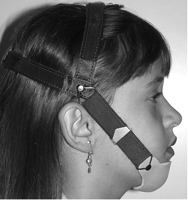
Elastics
Rubber bands, latex or latex-free, used to exert a pulling force between dental arches in any direction/orientation which the Orthodontist prescribes to correct a malocclusion. Found in numerous colors for better appearance. Read more about elastics. Watch a video on Elastics.
Forsus Appliance
A spring-loaded, fixed-functional appliance used to correct excessive overjet, Class II Malocclusion cases.
Watch a video on the Forsus Appliance.
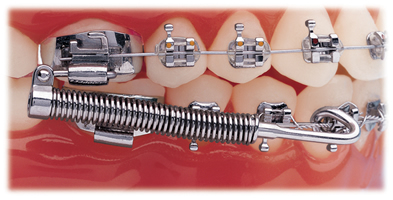
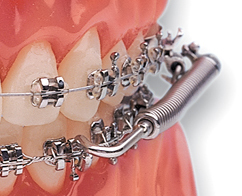
Frenectomy
A periodontal, surgical procedure to clip or reduce the size or length of a frenum. Commonly used to relieve excess fibers of the lingual (tongue) frenum, known as tongue-tie correction, or to reduce the attachment point of a labial (lip) frenum. In Orthodontics, labial frenectomies are commonly requested to reduce the maxillary (upper) labial frenum in order to keep a space (diastema) between the front teeth closed. Read more about it here.
Gingivectomy/Gingivoplasty
In Orthodontics, a procedure usually performed with a soft-tissue laser to re-contour the gingival margin where the gum meets the teeth. Excess tissue is usually removed to beautify the smile and facilitate improved oral hygiene by reducing pocket or sulcus depths. Read more about it here. See before and after images here.
Headgear
Generic term for extraoral traction which may incorporate a strap to the back side of the head or neck for growth modification, tooth movement and anchorage. Learn more about Headgear. Watch a video on Headgear.
Interproximal Reduction
The removal of some of the outer tooth surface, called enamel, usually between teeth that touch; it has been used in orthodontics since the 1940s. It is also known as slenderizing, stripping, enamel reduction, reproximation and selective reduction.Read more about interproximal reduction. Watch a video on Interproximal Reduction.
Koby Ties/Hooks
Hooks attached to individual brackets/braces for attachment points for elastics or rubber bands.
Ligature
An elastic or stainless steel wire used to hold the main orthodontics archwire into each individual bracket or brace. It is the elastic ligatures or ties which are colored to appeal to patients with traditional, non self-ligating, braces.
RPE (Rapid-Palatal Expander)
Rapid Palatal Expander is an orthodontic device used to create a wider upper arch, usually used to correct crossbites.Read more about it here. Watch a video on RPE (Rapid-Palatal Expander).
Retainer
- Bonded / Fixed / Permanent – a small diameter wire is glued behind the teeth, negating the need in most cases for a removable retainer
- Removable - Hawley -Traditional retainers with medium gauge steel wires embedded in a pink or customizable acrylic
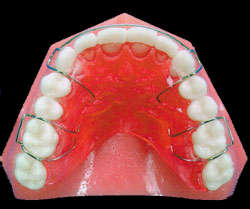
- Removable - Essix- Clear plastic retainer, very aesthetic but typically does not last as long as Hawley retainers
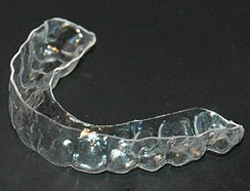
Read more about Retainers.
Serial Extraction
A process by which a series of baby/primary tooth extractions and, ultimately, the permanent first premolars, leads to comfortably fitting large teeth into small jaw bone arches. This process can shorten the time in full braces and facilitate the full braces treatment. Watch a video on Serial Extraction.
Soft-Tissue Laser
Read about these procedures. See before and after images here.
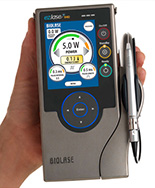
- Additionally, a laser can be used to expose a stubborn, unerupted tooth to speed up the orthodontics treatment.
- Most laser procedures only require topical anesthetic.
TAD (Mini-screw)
- Provides skeletal anchorage so as to minimize or avoid adverse effects of moving some teeth at the expense of the other teeth providing that pulling or pushing force.
- Great for compensating for skeletal (jaw bone) discrepancies, even to the point of avoiding jaw bone surgery in some cases
- Very easy procedure involving topical anesthetic and a small anesthetic shot
- Can speed up tooth movement and decrease overall treatment time
- Read more about TAD's.
Watch a video on TAD (Mini-screw).
TPA (Trans-Palatal Arch)
A single wire appliance custom formed to contour to the roof of the mouth, or palate. Used to give transverse stability during.
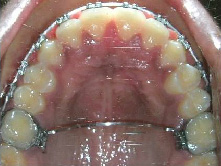
Tubes
The "braces" of the large molars at the back of an arch. Rather than a slot in a bracket, molars typically get a covered slot, or tube, which can be directly bonded to the molars like the other brackets/braces or it can be spot-welded to a metal band (ring) to be cemented to the molars.

A spring-loaded, fixed-functional appliance used to correct excessive overjet, Class II Malocclusion cases. Watch a video on Twin-Force Bite Corrector.